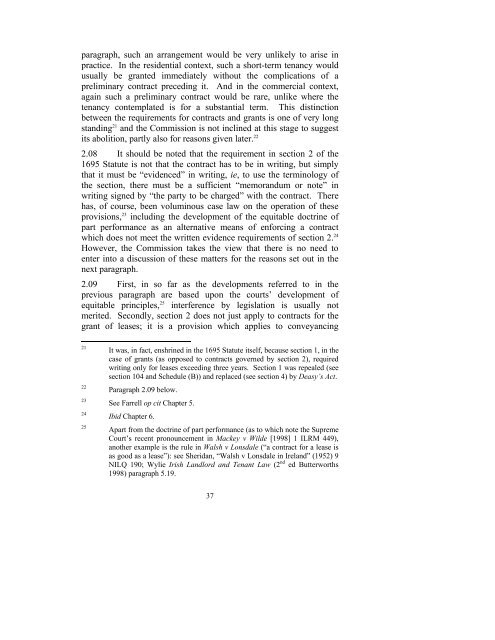Consultation Paper on the General Law of the Landlord and Tenant
Consultation Paper on the General Law of the Landlord and Tenant
Consultation Paper on the General Law of the Landlord and Tenant
You also want an ePaper? Increase the reach of your titles
YUMPU automatically turns print PDFs into web optimized ePapers that Google loves.
paragraph, such an arrangement would be very unlikely to arise inpractice. In <strong>the</strong> residential c<strong>on</strong>text, such a short-term tenancy wouldusually be granted immediately without <strong>the</strong> complicati<strong>on</strong>s <strong>of</strong> apreliminary c<strong>on</strong>tract preceding it. And in <strong>the</strong> commercial c<strong>on</strong>text,again such a preliminary c<strong>on</strong>tract would be rare, unlike where <strong>the</strong>tenancy c<strong>on</strong>templated is for a substantial term. This distincti<strong>on</strong>between <strong>the</strong> requirements for c<strong>on</strong>tracts <strong>and</strong> grants is <strong>on</strong>e <strong>of</strong> very l<strong>on</strong>gst<strong>and</strong>ing 21 <strong>and</strong> <strong>the</strong> Commissi<strong>on</strong> is not inclined at this stage to suggestits aboliti<strong>on</strong>, partly also for reas<strong>on</strong>s given later. 222.08 It should be noted that <strong>the</strong> requirement in secti<strong>on</strong> 2 <strong>of</strong> <strong>the</strong>1695 Statute is not that <strong>the</strong> c<strong>on</strong>tract has to be in writing, but simplythat it must be “evidenced” in writing, ie, to use <strong>the</strong> terminology <strong>of</strong><strong>the</strong> secti<strong>on</strong>, <strong>the</strong>re must be a sufficient “memor<strong>and</strong>um or note” inwriting signed by “<strong>the</strong> party to be charged” with <strong>the</strong> c<strong>on</strong>tract. Therehas, <strong>of</strong> course, been voluminous case law <strong>on</strong> <strong>the</strong> operati<strong>on</strong> <strong>of</strong> <strong>the</strong>seprovisi<strong>on</strong>s, 23 including <strong>the</strong> development <strong>of</strong> <strong>the</strong> equitable doctrine <strong>of</strong>part performance as an alternative means <strong>of</strong> enforcing a c<strong>on</strong>tractwhich does not meet <strong>the</strong> written evidence requirements <strong>of</strong> secti<strong>on</strong> 2. 24However, <strong>the</strong> Commissi<strong>on</strong> takes <strong>the</strong> view that <strong>the</strong>re is no need toenter into a discussi<strong>on</strong> <strong>of</strong> <strong>the</strong>se matters for <strong>the</strong> reas<strong>on</strong>s set out in <strong>the</strong>next paragraph.2.09 First, in so far as <strong>the</strong> developments referred to in <strong>the</strong>previous paragraph are based up<strong>on</strong> <strong>the</strong> courts’ development <strong>of</strong>equitable principles, 25 interference by legislati<strong>on</strong> is usually notmerited. Sec<strong>on</strong>dly, secti<strong>on</strong> 2 does not just apply to c<strong>on</strong>tracts for <strong>the</strong>grant <strong>of</strong> leases; it is a provisi<strong>on</strong> which applies to c<strong>on</strong>veyancing2122232425It was, in fact, enshrined in <strong>the</strong> 1695 Statute itself, because secti<strong>on</strong> 1, in <strong>the</strong>case <strong>of</strong> grants (as opposed to c<strong>on</strong>tracts governed by secti<strong>on</strong> 2), requiredwriting <strong>on</strong>ly for leases exceeding three years. Secti<strong>on</strong> 1 was repealed (seesecti<strong>on</strong> 104 <strong>and</strong> Schedule (B)) <strong>and</strong> replaced (see secti<strong>on</strong> 4) by Deasy’s Act.Paragraph 2.09 below.See Farrell op cit Chapter 5.Ibid Chapter 6.Apart from <strong>the</strong> doctrine <strong>of</strong> part performance (as to which note <strong>the</strong> SupremeCourt’s recent pr<strong>on</strong>ouncement in Mackey v Wilde [1998] 1 ILRM 449),ano<strong>the</strong>r example is <strong>the</strong> rule in Walsh v L<strong>on</strong>sdale (“a c<strong>on</strong>tract for a lease isas good as a lease”): see Sheridan, “Walsh v L<strong>on</strong>sdale in Irel<strong>and</strong>” (1952) 9NILQ 190; Wylie Irish <strong>L<strong>and</strong>lord</strong> <strong>and</strong> <strong>Tenant</strong> <strong>Law</strong> (2 nd ed Butterworths1998) paragraph 5.19.37
















